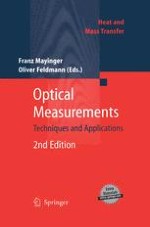Increasing possibilities of computer-aided data processing have caused a new revival of optical techniques in many areas of mechanical and chemical engi neering. Optical methods have a long tradition in heat and mass transfer and in fluid dynamics. Global experimental information is not sufficient for de veloping constitution equations to describe complicated phenomena in fluid dynamics or in transfer processes by a computer program. Furthermore, a detailed insight with high local and temporal resolution into the thermo and fluiddynamic situations is necessary. Sets of equations for computer program in thermo dynamics and fluid dynamics usually consist of two types of formulations: a first one derived from the conservation laws for mass, energy and momentum, and a second one mathematically modelling transport processes like laminar or turbulent diffusion. For reliably predicting the heat transfer, for example, the velocity and temperature field in the boundary layer must be known, or a physically realistic and widely valid correlation describing the turbulence must be avail able. For a better understanding of combustion processes it is necessary to know the local concentration and temperature just ahead of the flame and in the ignition zone.
